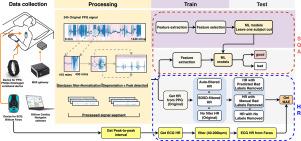Assessing the impact of signal quality on heart rate detection from long-term clinical wrist PPG under varying cardiac rhythms
IF 4.9
2区 医学
Q1 ENGINEERING, BIOMEDICAL
引用次数: 0
Abstract
Reliable heart rate (HR) detection is essential for long-term cardiac monitoring, particularly in hospitalized patients with complex conditions. Due to its optical and non-invasive nature, photoplethysmography (PPG) is inherently susceptible to motion artifacts and noise. These challenges intensify under arrhythmic conditions such as atrial fibrillation (AF), where signal distortions may blur the boundary between poor-quality segments and pathological rhythms, potentially impairing downstream tasks like HR estimation. This study developed a signal quality assessment (SQA) algorithm designed for this high-risk clinical population and evaluated its robustness through HR estimation. We collected 24-hour synchronous PPG and electrocardiogram (ECG) recordings from 49 hospitalized cardiac patients, with all PPG segments manually annotated for quality. External validation was conducted using the MIMIC-IV dataset. To avoid dependence on specific segment lengths or classifier types, we assessed SQA performance using seven machine learning models and four segmentation lengths. The SQA framework was then applied to HR estimation to evaluate clinical utility. We implemented a Standard Deviation of Successive Differences (SDSD)-based peak filtering method and compared it with an autocorrelation-based approach under different cardiac rhythm conditions. Threshold tuning in both SQA classification and SDSD filtering was conducted to explore the balance between data usability and reliable HR estimation. The proposed model achieved an AUROC of 96.1% (Sinus Rhythm (SR) + AF), with 90.6% on MIMIC-IV. Predicted SQA labels closely matched manual annotations, with mean absolute error (MAE) differences of 0.08 bpm (SR+AF), 0.25 bpm (SR), 0.62 bpm (AF), and 0.53 bpm (MIMIC-IV). SDSD reduced MAE by 46.57% for SR+AF, 41.67% for SR, and 49.69% for AF, further demonstrating the effectiveness of integrating SQA into HR estimation workflows.

评估不同心律下长期临床手腕PPG信号质量对心率检测的影响
可靠的心率(HR)检测对于长期心脏监测至关重要,特别是对于病情复杂的住院患者。由于其光学和非侵入性,光容积脉搏波(PPG)天生就容易受到运动伪影和噪声的影响。这些挑战在心律失常的情况下加剧,如心房颤动(AF),其中信号失真可能模糊低质量段和病理节律之间的界限,潜在地损害下游任务,如HR估计。本研究针对这一临床高危人群开发了一种信号质量评估(SQA)算法,并通过HR估计评估其稳健性。我们收集了49名住院心脏病患者的24小时同步PPG和心电图(ECG)记录,并对所有PPG片段进行了手工注释以保证质量。外部验证使用MIMIC-IV数据集进行。为了避免对特定片段长度或分类器类型的依赖,我们使用七个机器学习模型和四个片段长度来评估SQA性能。然后将SQA框架应用于HR估计以评估临床效用。我们实现了一种基于连续差异标准差(SDSD)的峰值滤波方法,并将其与基于自相关的方法在不同心律条件下进行了比较。在SQA分类和SDSD过滤中进行阈值调优,以探索数据可用性和可靠HR估计之间的平衡。该模型的AUROC为96.1%(窦性心律(SR) + AF), MIMIC-IV为90.6%。预测的SQA标签与手动注释紧密匹配,平均绝对误差(MAE)差异为0.08 bpm (SR+AF), 0.25 bpm (SR), 0.62 bpm (AF)和0.53 bpm (MIMIC-IV)。SDSD将SR+AF的MAE降低了46.57%,SR降低了41.67%,AF降低了49.69%,进一步证明了将SQA集成到人力资源估计工作流中的有效性。
本文章由计算机程序翻译,如有差异,请以英文原文为准。
求助全文
约1分钟内获得全文
求助全文
来源期刊

Biomedical Signal Processing and Control
工程技术-工程:生物医学
CiteScore
9.80
自引率
13.70%
发文量
822
审稿时长
4 months
期刊介绍:
Biomedical Signal Processing and Control aims to provide a cross-disciplinary international forum for the interchange of information on research in the measurement and analysis of signals and images in clinical medicine and the biological sciences. Emphasis is placed on contributions dealing with the practical, applications-led research on the use of methods and devices in clinical diagnosis, patient monitoring and management.
Biomedical Signal Processing and Control reflects the main areas in which these methods are being used and developed at the interface of both engineering and clinical science. The scope of the journal is defined to include relevant review papers, technical notes, short communications and letters. Tutorial papers and special issues will also be published.
 求助内容:
求助内容: 应助结果提醒方式:
应助结果提醒方式:


